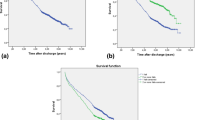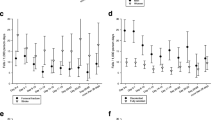Summary.
Background: A fall in old age is known as a common consequence of frailty and decline as well as a risk factor for further falls. Studies identifying hip fracture patients who are at risk of a further fall are lacking. Therefore it was of interest to evaluate the risk factors for falling in a high-risk population, i.e., patients during rehabilitation after recent proximal femur fracture. Methods: 935 consecutive patients who had surgical intervention after acute fracture of the proximal femur underwent a multidimensional assessment within the first two days after admission to the rehabilitation ward. Falls during the stay on the rehabilitation ward were registered. The baseline data were compared between fallers and non-fallers. Findings: 11.8% of the patients fell during rehabilitation. Risk factors associated with a fall were increasing age, male gender, type of surgery, the use of a rollator and nocturnal urinary incontinence. The risk of falling increased in the middle of the second week of rehabilitation, when frailer patients gained mobility and ability to walk by themselves, while they were not yet safe enough. Interpretation: It was possible to compose a risk profile for future falls. Those identified as ’at risk of a further fall‘ should be selectively offered protective devices and special training programs in order to prevent future fractures. As for the surgical intervention, the type of surgery in relation to age and long-term outcome is of particular interest since the use of the more expensive total hip arthroplasty procedure may be more cost effective in the long term.
Zusammenfassung.
Hintergrund: Stürze sind bekannte Folgen von allgemeiner Schwäche und Gebrechlichkeit älterer Menschen, gleichzeitig aber auch der wichtigste Risikofaktor für einen weiteren Sturz. Es fehlen Studien, die das Sturzrisiko von Patienten nach Schenkelhalsfraktur evaluieren. Deshalb wurden Patienten im Rahmen der Rehabilitation nach hüftgelenksnaher Femurfraktur bezüglich ihres weiteren Sturzrisikos evaluiert. Patienten und Methode: Es wurden 935 Patienten nach chirurgischer Sanierung einer hüftgelenksnahen Femurfraktur im Rahmen der Aufnahmeuntersuchung zur Rehabilitation im Sinne eines multidimensionalen Geriatrischen Assessment untersucht. Die Stürze während der Rehabilitation wurden exakt dokumentiert und die Basisdaten des Assessments zwischen „Stürzern“ und „Nicht-Stürzern“ verglichen. Ergebnisse: 11,8% der Patienten stürzten während der Rehabilitation. Als spezielle Risikofaktoren konnten das Alter per se, das männliche Geschlecht, der Bedarf eines Rollators und nächtliche Inkontinenz identifiziert werden. Das Sturzrisiko nahm während der zweiten Woche signifikant zu. Bei zunehmender Mobilität, ohne gleichzeitige Sicherheit, stieg das Sturzrisiko insbesondere für die gebrechlichen Patienten. Diskussion: Im Rahmen der Studie konnte ein besonderes Risikoprofil in dieser Hochrisikogruppe identifiziert werden. Jenen Patienten sollte während der Rehabilitation spezielle Trainingsprogramme und protektive Maßnahmen angeboten werden, um eine weitere Fraktur zu verhindern. Gleichzeitig bedarf es weiterer Studien, um den Einfluss der verwendeten Osteosynthese auf das Sturzrisiko zu überprüfen.
Similar content being viewed by others
Author information
Authors and Affiliations
Additional information
Received: 23 September 2002 Accepted: 15 November 2002
Acknowledgments. The project was granted by AUVA (Workers Compensation Society Austria).
Correspondence to Katharina Pils
Rights and permissions
About this article
Cite this article
Pils, K., Neumann, F., Meisner, W. et al. Predictors of falls in elderly people during rehabilitation after hip fracture – who is at risk of a second one?. Z Gerontol Geriat 36, 16–22 (2003). https://doi.org/10.1007/s00391-003-0142-9
Issue Date:
DOI: https://doi.org/10.1007/s00391-003-0142-9




